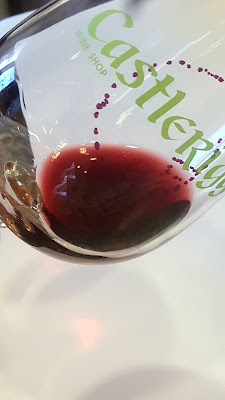What piqued my interest was the precise blend of ingredients:
- 13% ale
- 55% ale aged in wine barrels
- 32% ale aged in bourbon barrels
I'm not sure why they didn't just go with round numbers. Now, we all know what aging in barrels does to alcohol, so this peculiar blend gives a slight suggestion about what's in store - probably lots of woodiness and some dry oakiness from the wine barrels. Today's bottle has been aging in my cellar for two years, which of course has changed the beer a bit, but not too far off I hope.
Comes in a cork-and-cage 750mL bottle. Poured, it's got a dark brown, almost root-beer color in the glass. Smells a LOT like apple cider and alcohol. As usual with beers like this, I let it sit for 10+ minutes, warming up and opening up to the air.
Wow, yes, there's a full, deep taste of whiskey almost immediately after drinking. That flavor develops into an earthy, slightly sweet malty flavor with a strong finish of brown sugar. The texture (aka "mouthfeel") is like a dark apple cider, albeit with not as much astringent citrus.
This beer has some subtle qualities to it, like the richness and depth of flavor, but also retains a strong whiskey, slightly tangy taste. It's nice to have that balance of flavors, not always encountered by the way. Sometimes beers are too soft, or too harsh, but this one was just right.
I will certainly revisit this in a few years. I've got one more in my cellar, so perhaps in 2018 I'll come back to it and see how it has changed. For now, what a delicious beer! Too bad they don't sell these as a regular run, it's a perfect autumn / winter beer.
Comes in a cork-and-cage 750mL bottle. Poured, it's got a dark brown, almost root-beer color in the glass. Smells a LOT like apple cider and alcohol. As usual with beers like this, I let it sit for 10+ minutes, warming up and opening up to the air.
Wow, yes, there's a full, deep taste of whiskey almost immediately after drinking. That flavor develops into an earthy, slightly sweet malty flavor with a strong finish of brown sugar. The texture (aka "mouthfeel") is like a dark apple cider, albeit with not as much astringent citrus.
This beer has some subtle qualities to it, like the richness and depth of flavor, but also retains a strong whiskey, slightly tangy taste. It's nice to have that balance of flavors, not always encountered by the way. Sometimes beers are too soft, or too harsh, but this one was just right.
I will certainly revisit this in a few years. I've got one more in my cellar, so perhaps in 2018 I'll come back to it and see how it has changed. For now, what a delicious beer! Too bad they don't sell these as a regular run, it's a perfect autumn / winter beer.



















































